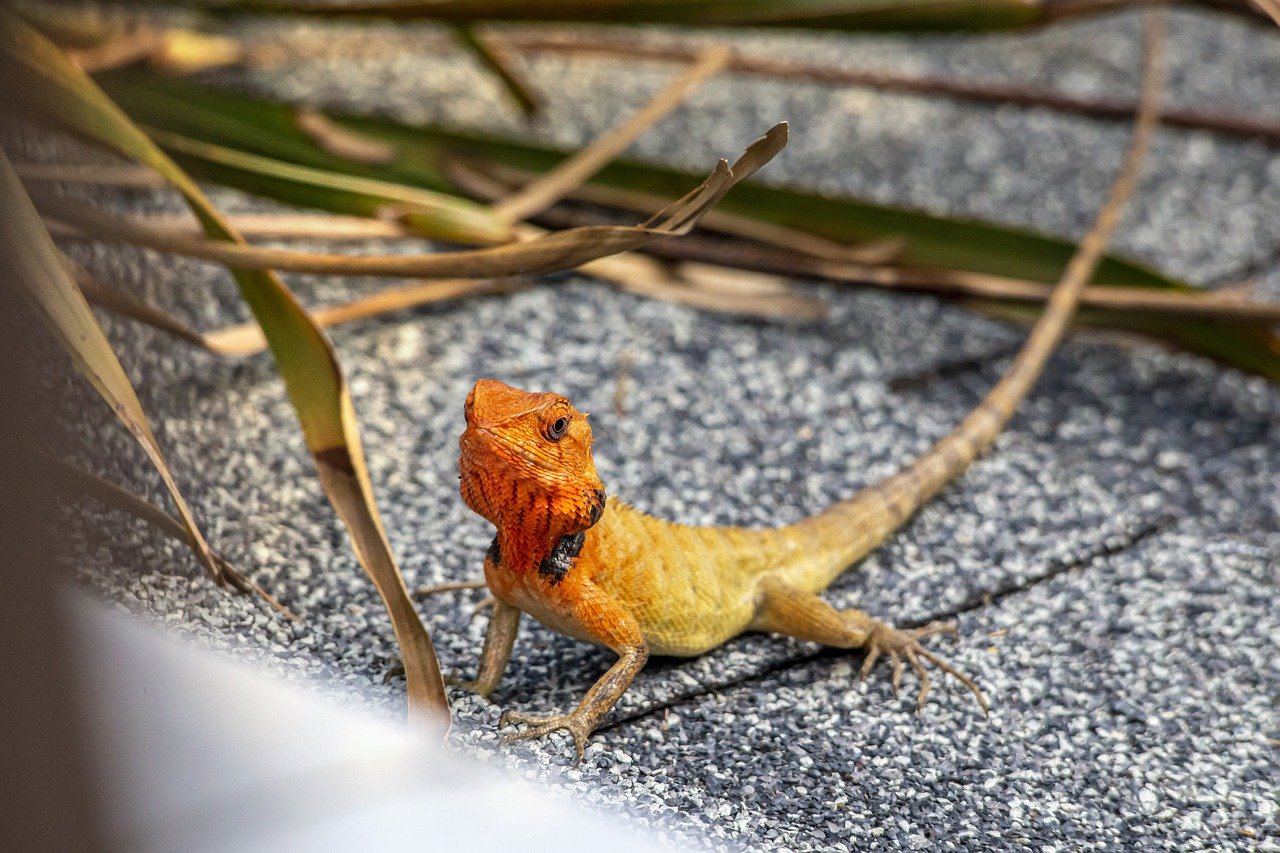The Oriental Garden Lizard (Calotes versicolor), also known as the Changeable Lizard, is one of the most widespread and adaptable reptiles in Asia.
Here is a deep review covering its taxonomy, morphology, behavior, diet, and ecological role.
🦎 Oriental Garden Lizard (Calotes versicolor) Deep Review
1. Taxonomy and Distribution
- Kingdom/Phylum/Family: Animalia / Chordata / Agamidae (Agamas, or “dragon lizards”)
- Genus/Species: Calotes versicolor
- Common Names: Oriental Garden Lizard, Changeable Lizard, Indian Garden Lizard, Common Garden Lizard, and colloquially, Bloodsucker (a misnomer due to the male’s red breeding coloration, as it does not suck blood).
Geographic Range
- Native Range: Wide distribution across Indo-Malaya, including South and Southeast Asia (from Iran, Afghanistan, and Nepal to India, Sri Lanka, the Malay Peninsula, and parts of Southern China and the Philippines).
- Habitat Adaptability: Highly adaptable, thriving in diverse environments including scrub, open forests, plantations, but most notably in human-altered habitats like gardens, parks, and highly urban areas.
- Invasive Status: It has been introduced and established in other parts of the world, including parts of Africa (Kenya) and the United States (Florida), where its ecological impact is still being studied.
Species Complex
Recent molecular and morphological studies suggest that Calotes versicolor may actually be a species complex (meaning it contains multiple distinct, yet morphologically similar, species). For example, C. versicolor sensu stricto (the species in the strict sense) is now sometimes restricted to South and Northwest peninsular India, with other regional populations potentially being separate species (e.g., C. vultuosus, C. irawadi, C. htunwini).
2. Morphology and Key Features
| Feature | Description |
| Size | Medium-sized. Total length (including tail) up to 37–46 cm (14.5–18 inches). Snout-to-vent length (SVL) is typically over 10 cm (3.9 inches). |
| Coloration | Ground color is generally brownish, greyish-olive, or yellowish. The species is famous for its color-changing ability, regulated by environmental factors (light, temperature) and emotional states (fear, aggression, courtship). |
| Breeding Male | During the breeding season (May to October), the dominant male’s head, neck, and shoulders turn a striking bright orange to crimson red and the throat can turn black. This display led to the inaccurate “Bloodsucker” nickname. |
| Crests | Possesses a prominent nuchal and dorsal crest (a ridge of enlarged scales) extending from the back of the head down the neck and anterior part of the trunk. This gives them another common name: “crested tree lizard.” |
| Scales | Scales on the sides are characterized by a posterodorsal orientation (angled backward and upward). They have two small, separated groups of spines above each ear (tympanum). |
| Sexual Dimorphism | Males and females are similar in body size, but males have longer tails, larger heads, stronger jaw muscles, and more developed crests/spines. |
| Tail | Unlike some other lizard species, C. versicolor does not practice autotomy (tail dropping), and the tail is long, stiff, and pointy. |
| Eyes | Like chameleons, they have independent eye movement, allowing each eye to track different targets simultaneously. |
3. Behavior and Ecology
Activity and Thermoregulation
- Diurnal: They are active during the daytime.
- Semi-Arboreal/Terrestrial: They are adept climbers (arboreal) but frequently come down to the ground (terrestrial) to forage. They are often seen on tree trunks, branches, fences, and low shrubs.
- Basking: They are open or partial sun baskers (Ferguson Zone 3), needing a basking spot of up to $40^\circ \text{C}$ to regulate their body temperature. They often bask with their mouths open on very hot days.
Social Behavior and Reproduction
- Solitary and Territorial: They are generally solitary. Males become highly territorial during the breeding season.
- Display Behavior: Males perform elaborate visual displays to discourage rivals and attract females, including:
- Brightening their heads to crimson.
- Inflating the throat (sometimes a small dewlap is visible).
- Performing rhythmic “push-ups” (head bobbing).
- A victorious male may maintain its bright red coloration after subduing a rival.
- Reproduction: They are oviparous (egg-laying). Females lay about 10–20 eggs, burying them in moist soil in the summer months (May–October).
Diet and Foraging
- Carnivore (Insectivore): Their diet primarily consists of a wide range of arthropods (insects, spiders, myriapods) and other small invertebrates. They are considered effective bioregulators of crop pests.
- Apex Predator (in their size class): Larger adults are known to occasionally consume small vertebrates, including small birds (and nestlings), frogs, geckos, small snakes, and, notably, their own young (cannibalism).
- Hunting Strategy: They are primarily ambush predators (sit-and-wait). They rely on excellent vision to detect prey movement, rushing down from a perch in quick sprints to grasp the prey. They typically shake the prey to stun it, then swallow it whole, as their teeth are for gripping, not tearing.
- Plant Matter: They occasionally consume plant matter, including licking nectar from blossoms.
4. Conservation Status and Ecological Role
- IUCN Status: Least Concern (LC).
- Population Trend: Stable.
- Resilience: The species is highly successful and resilient due to its wide distribution, generalist diet, and exceptional adaptability to human-modified landscapes. They are prolific breeders, supporting stable populations even in urban environments.
- Ecological Significance:
- Pest Control: Their role as voracious insectivores is vital in controlling insect populations in both natural and agricultural settings.
- Food Web: They serve as a prey item for various larger predators, including birds (e.g., raptors) and snakes.
The Oriental Garden Lizard is a perfect example of a successful, widespread, and ecologically significant reptile that manages to coexist seamlessly with human civilization, despite the challenges that urbanization typically presents to wildlife.
Views: 1225
Subscribe to the newsletter:
